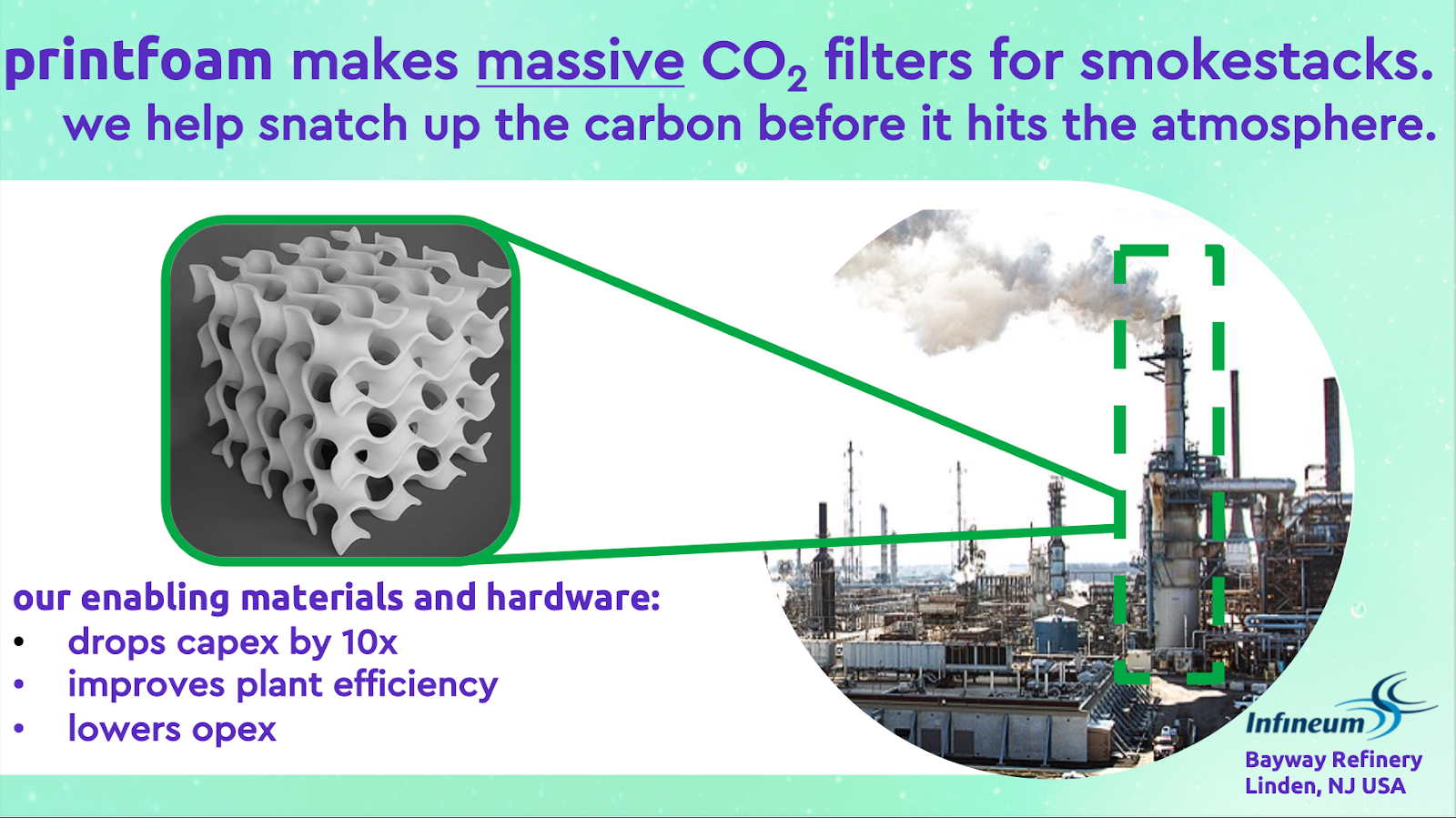Application Spotlight: PrintFoam for Carbon Capture
“So you 3D print foam? That means you make, what, shoes and footwear?”
No, that’s not what we’re looking to do – we’re looking to make a bigger impact and play in a bigger playground. Don’t get us wrong; 3D printed footwear is great and frankly very comfortable (and/or artistic), and we give huge kudos to the players doing it right.
But we want to stay true to our roots and leverage the best of what PrintFoam technology can do. Environmental awareness is a major part of our background story, and it’s a big part of our future story, too.
We’re focusing first in terms of addressable applications on climate infrastructure, and in particular carbon capture.
Carbon Capture
“Even as nations diversify their energy portfolios, fossil fuels are expected to meet a majority of the world’s energy demand for several decades. Accelerating deployment of carbon capture technology is essential to reduce emissions from these power plants, and from industrial plants like cement and steel manufacturing,” notes the Center for Climate and Energy Solutions.
The world’s unending need for power needn’t rely on finite energy sources – but while it does, carbon capture offers a way to combat the exponentially negative impact of climate change. Advanced technologies can advance the science, potential, and ultimately capability of carbon capture. This is no secret to the additive manufacturing industry at large, and organizations like Lawrence Livermore National Labs (LLNL) have undertaken in-depth research to understand how 3D printed reactor internals can enhance performance. LLNL researchers have found that under certain conditions they can reduce tower heights by 20%. This can drastically reduce installed costs and operating costs by optimizing the structures.
A variety of 3D printing technologies have so far come under examination and, having taken deep dives into available data, we believe PrintFoam offers a uniquely accessible, scalable, cost-effective, and – above all – impactful solution for carbon capture applications.
Basically, we want to 3D print high surface area parts that can filter out the carbon dioxide from chemical reactors at refineries, power plants, cement facilities, and steel mills. This enables point source capture for traditionally hard to decarbonize industries.
Point Source Capture
As we laid it out at the top of the New Year, PrintFoam enables faster, lighter, cheaper 3D printing. That is: our technology uses less material, cures faster because of that lower material content, and doesn’t need as much support in the structure.
“We have plans to fill literal shipping containers full of structured foam parts that are optimized for pressure drop, mass transfer, and temperature regulation. It's a wild idea, I know….but that's how we are going to change the world,” says PrintFoam Founder and CEO Matthew Pearlson.
“Imagine a world of plastic made from plants, that can filter CO2 like a leaf, and at the end of its working life be biodegradable and returned to the ground where it came from. It’s the complete CO2 solution. Our team of experts has decades of experience developing novel, cutting edge, nanotechnologies, and nanomaterials – and commercializing those research inventions to real world innovations.”
While diving into the world of carbon capture and real-world potential impact, we have been scouring active sources to determine the current state of this application area. Occidental Petroleum (Oxy) and their Low Carbon Ventures group offers notable background on the climate/carbon market opportunity in its recent investor updates.
From these resources, we have come to understand the shape of the market and areas where our technology can most impactfully come into play. While we are confident PrintFoam technology is applicable in point source capture as well as larger direct air capture applications, it makes more sense to focus on point source. Our current focus in this area is in reactor internals in this industrial space – with the capability to expand into adjacent markets like optimized heat exchangers with metal casting, or kicking up the complexity and integrating electric heaters directly into the reactor internals.
As industry moves carbon neutrality, both voluntarily as well as in response to particular policy drivers like the Paris Agreement, the total addressable market is in the scale of trillions of dollars globally. Capturing carbon before it hits the atmosphere is just the beginning of the move toward a more carbon-neutral world.
3D Printed Foam for Carbon Capture
Because the industry needs more efficient and lower-cost carbon capture, utilization, and storage solutions – and LLNL research has highlighted that 3D printing can substantially enhance reactor internals – the real need to advance this opportunity comes in the form of scale. That is: Conventional 3D printing is too small, too slow, and too expensive to substantively address this application.
Enter PrintFoam.
PrintFoam has proprietary materials and equipment that make carbon capture 10x more efficient than other solutions. Beyond legacy tech – think Raschig rings, structured packing – and other 3D printing solutions – like direct ink writing, held back by low resolution and simple structures – PrintFoam can create faster filters that capture more CO2 and cost less to create.
Foam in particular is well-suited as a material of choice for 3D printed carbon capture due to its inherent benefits in several key areas:
Thin foam walls filter carbon faster
More filter area captures more carbon
The high surface area-to-volume and strength-to-weight structures enabled by 3D printed foam create new possibilities for effective carbon capture.
It’s also a lot cheaper than other material types – because it’s mostly air.
Further, competitive offerings on the market today only tick two of the three necessary boxes to play in the carbon capture space:
Size
Speed
Resolution
PrintFoam is a solid three-for-three here.
When we look toward our first beachhead customer, carbon capture is a no-brainer. Let’s put foam to its best use: our world.

